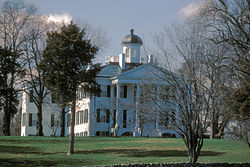The Tuleyries
The Tuleyries | |
 The Tuleyries, March 1971 | |
| Location | 1.5 mi. E of White Post off VA 628, White Post, Virginia |
|---|---|
| Coordinates | 39°4′16″N 78°4′26″W / 39.07111°N 78.07389°W |
| Area | 20 acres (8.1 ha) |
| Built | 1833 |
| Architectural style | Federal, Late Federal |
| NRHP reference No. | 72001388[1] |
| VLR No. | 021-0082 |
| Significant dates | |
| Added to NRHP | August 7, 1972 |
| Designated VLR | July 6, 1971[2] |
The Tuleyries is an ante-bellum estate near White Post, Virginia.[3]
History
The complex was built around 1833 by Colonel Joseph Tuley, Jr. (1796–1860), a large slaveholder,[4] who made the name a pun on his name and the Tuileries Palace. The house is a late Federal style mansion with a domed entrance hall. The house was sold by the Tuley family to Colonel Upton Lawrence Boyce (1830–1907) in 1866.
In 1903 the property was acquired by Graham Furber Blandy (1868–1926), who hired Philadelphia architect Mantle Fielding (1865–1941) to restore and improve the mansion.[5] Two-thirds The Tuleyries – as part of The Estate of Graham Furber Blandy, Deceased – was bequeathed to the University of Virginia.
That land is now known as the Blandy Experimental Farm and The Virginia State Arboretum. The remaining property and house remained in the Blandy family.[6] As well as twenty acres of lawn and garden the property includes a further three hundred and eighty six acres of forest and farm.
It was listed on the National Register of Historic Places in 1972.[1]
Bibliography
Notes
- ^ a b NRIS database.
- ^ Virginia Landmarks Register.
- ^ Baker, 1930, p. 170.
- ^ "Tuleyries" Nomination, August 7, 1972, p. 3.
- ^ Boxwood Bulletin, April 1964, pp. 59–60.
- ^ "Tuleyries" Nomination, August 7, 1972.
References
- Baker, "Nellie" Browne (née Ellen Fauntleroy Browne; 1882–1975) (entry) (1930) [1929]. Christian, Frances Archer (née Frances Williamson Archer; 1864–1968); Massie, Susanne Williams (née Susanne Coleman Williams; 1861–1952) (eds.). Entry → "The Tuleyries" in Homes and Gardens in Old Virginia. Richmond: J.W. Fergusson & Sons. p. 170 – via Internet Archive (Marygrove College).
{{cite book}}: CS1 maint: multiple names: authors list (link) CS1 maint: numeric names: authors list (link) LCCN 30-13228; OCLC 9800024 (all editions)."The Tuleyries". Homes and Gardens in Old Virginia (revision of the 1929 1st ed.). Richmond: Garden Club of Virginia. 1953. pp. 517–519. Retrieved August 25, 2022 – via HathiTrust (UC Davis) . LCCN 53-11461; OCLC 1658741 (all editions).
. LCCN 53-11461; OCLC 1658741 (all editions).
- Boxwood Bulletin (The); Wilson, Alice B. (Alice Elsie "Ella" née Borland; 1887–1987) (April 1964). "The Tuleyries" (PDF).
 . 3 (4). Boyce, Virginia: American Boxwood Society: 59–60. Retrieved August 24, 2022.
. 3 (4). Boyce, Virginia: American Boxwood Society: 59–60. Retrieved August 24, 2022. {{cite journal}}: Cite journal requires|journal=(help)CS1 maint: multiple names: authors list (link) CS1 maint: numeric names: authors list (link) ISSN 0006-8535; OCLC 2445419.
- "NRIS – National Register Information System". National Register of Historic Places. National Park Service. Retrieved July 9, 2010.
- "Tuleyries" ("The") – Nomination (PDF). National Register of Historic Places. August 7, 1972. Retrieved July 2, 2008.
- "Virginia Landmarks Register". Virginia Department of Historic Resources. Retrieved June 5, 2013. (NRIS Nomination (PDF) (stored online by the Virginia Landmarks Register). Retrieved August 24, 2022.).
External links
 Media related to The Tuleyries at Wikimedia Commons
Media related to The Tuleyries at Wikimedia Commons- Tuleyries, State Route 628 vicinity, White Post, Clarke County, VA at the Historic American Buildings Survey (HABS)
- Houses in Clarke County, Virginia
- Houses completed in 1833
- Federal architecture in Virginia
- Plantation houses in Virginia
- Houses on the National Register of Historic Places in Virginia
- National Register of Historic Places in Clarke County, Virginia
- Historic American Buildings Survey in Virginia
- Shenandoah Valley, Virginia Registered Historic Place stubs
- Clarke County, Virginia geography stubs





